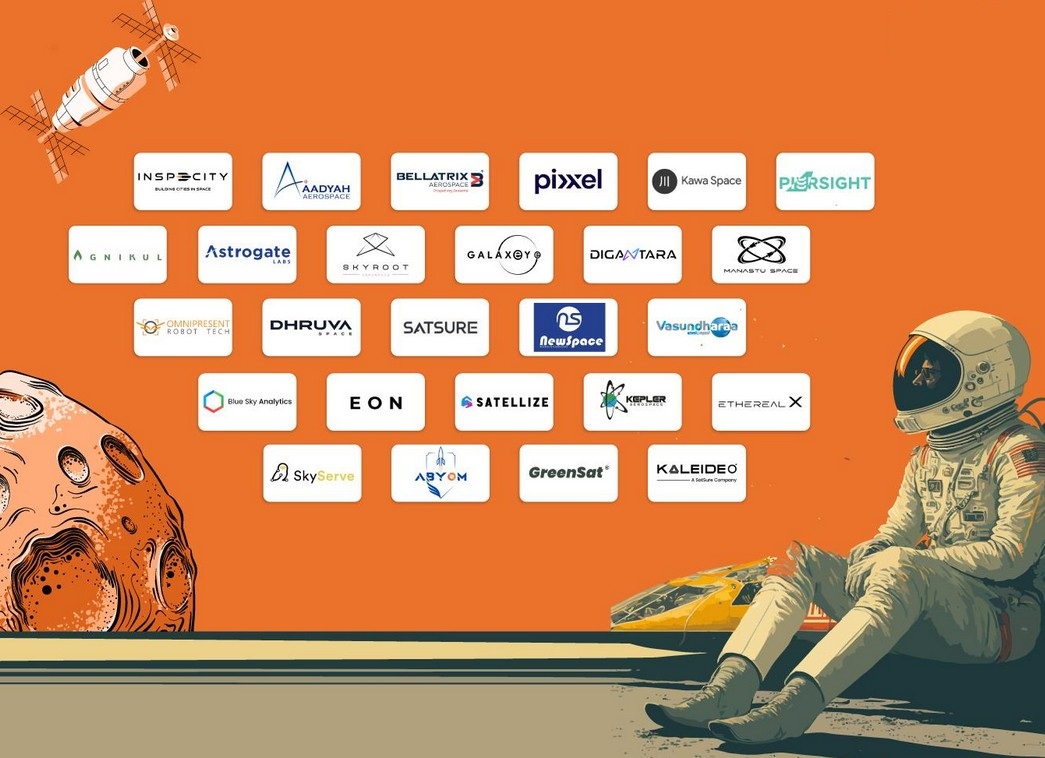N4S
UPSC often asks questions about India’s space sector by linking technology with governance, economy, and global partnerships (e.g., India’s role in commercial space or policy hurdles). Many aspirants struggle because they focus only on technology and ISRO’s achievements but ignore policy, private sector participation, and global trends. This article bridges that gap by covering India’s commercialization push, regulatory concerns (e.g., FDI policies), and lessons from global space economies (e.g., NASA-private sector collaborations). One standout feature of this piece is the BACK2BASICS section which gives an idea of the evolution of India’s space industry.
PYQ ANCHORING
- GS 3 : India has achieved remarkable successes in unmanned space missions including the Chandrayaan and Mars Orbitter Mission, but has not ventured into manned space mission, both in terms of technology and logistics? Explain critically. [ 2017]
- GS 3 : What is India’s plan to have its own space station and how will it benefit our space programme? [2019]
MICROTHEMES: Space Technology
India’s space sector is undergoing a remarkable transformation, not just in technology but also in how the ecosystem is structured. With ISRO handing over satellite launcher production to Hindustan Aeronautics Ltd (HAL), it signals a shift – freeing up resources to focus on frontier areas like reusable launch systems and space-based security. At the same time, a new wave of private startups like Skyroot Aerospace, Agnikul Cosmos, and Pixxel is bringing innovation, agility, and global aspirations into the mix. This evolving partnership between the public and private sectors could redefine India’s place in the global space economy – but the path ahead raises critical questions.
How effectively are private players being integrated into sensitive space missions? What regulatory safeguards are in place to balance innovation with national security? And who will shape the long-term vision for India’s space future – government agencies, private firms, or both?
Contribution of Private Sector to India’s Space sector expansion
| Key Area | Nature of Contribution | Examples / Substantiation |
| Private Sector Participation through IN-SPACe | Enabled greater collaboration between ISRO and Non-Governmental Entities (NGEs) through the establishment of IN-SPACe in 2020. | Skyroot Aerospace became the first private Indian company to launch a suborbital rocket (Vikram-S) in 2022. |
| Space Startups and Innovation Surge | Rapid growth of space tech startups working on launch vehicles, satellite manufacturing, and in-space services. | In 2021, Indian space startups raised $68 million—a 196% YoY increase. Agnikul Cosmos developed the mobile launchpad “Dhanush.” |
| Enhanced Public-Private Partnership | Collaborations between ISRO and industrial players like HAL, L&T, and Godrej Aerospace for manufacturing components of launch systems and spacecraft. | HAL has partnered with ISRO to manufacture PSLV components, contributing to over 60 successful launches. |
| Development of New Launch Vehicles and Infrastructure | Joint work on next-gen launch systems like Small Satellite Launch Vehicles (SSLVs) and Reusable Launch Vehicles (RLVs); establishment of space parks for manufacturing and R&D. | SSLV technology was successfully tested in 2023, offering low-cost, on-demand satellite launches. Space parks are being set up in Tamil Nadu and Gujarat. |
| International Collaborations and Commercialization | Enhanced global presence via commercial launches, satellite exports, and global partnerships through ISRO’s commercial arm, NSIL. | In 2023, India launched 42 foreign satellites. NSIL facilitated commercial launches and technology transfers. |
| Space-Based Applications and Societal Impact | Leveraging satellite technology for agriculture, remote sensing, digital inclusion, and disaster management. | Satellite services are projected to contribute 36% of the Indian space economy by 2025. Remote sensing and EO satellites support urban planning and precision farming. |
| Technological Advancements and Green Propulsion | Innovation in eco-friendly propulsion technologies and sustainable launch systems. | Bellatrix Aerospace is developing green propulsion and has signed international deals with UK and French firms, aligning with global sustainability trends in space tech. |
Key Concerns Associated with the Integration of Private Entities into India’s Space Sector
| Concern Area | Nature of Concern | Examples / Substantiation |
| Regulatory and Policy Challenges | Absence of a comprehensive legal framework creates uncertainty around space debris, liability, and IP rights. | Over 300 applications were submitted to IN-SPACe, but only 51 MoUs signed (Economic Survey 2023-24), suggesting policy ambiguity is stalling progress. |
| Intellectual Property (IP) Rights | ISRO’s collaboration model limits IP ownership for private players, discouraging investment in proprietary technology. | Startups have raised concerns that their innovations may be absorbed into ISRO’s ecosystem without full IP recognition, affecting innovation incentives. |
| Financial Sustainability and Investment Gaps | High entry costs and limited risk capital availability affect early-stage development and growth of space startups. | Govt announced a ₹1,000 crore VC fund, but global space investment fell from $47B (2021) to $20B (2022), per Space Capital, indicating shrinking appetite for risk in the sector. |
| National Security and Strategic Risks | Increased private involvement in dual-use technologies (civilian and military) could pose data and tech leakage risks. | Satellites like GSAT-7 are defense-linked; thus, uncontrolled access by private players could pose strategic vulnerabilities. |
| Technological Gaps and Expertise Constraints | Startups lack deep experience in complex tech areas such as orbital servicing, advanced propulsion, and scientific payloads. | While Skyroot and Agnikul are innovating with low-cost rockets, they are still far from handling interplanetary or large payload missions. |
| Fragmented Industry Structure | Over 200 startups work in silos across components like propulsion, avionics, and payloads without integrated coordination. | Lack of synergy slows down the development of end-to-end launch and satellite solutions, hampering commercialization. |
| Workforce Skill Deficiency | The sector lacks a sufficient number of trained professionals in critical domains like aerospace systems, control engineering, and satellite operations. | India’s higher education system still lacks dedicated training pipelines for space tech, leading to a talent bottleneck despite increasing demand. |
Key Takeaways from Global Space Commercialization
India’s space sector is at a turning point, moving from government-led missions to a more commercialized approach. As private players enter the scene, lessons from global leaders like the US, Europe, and China become crucial.
- Public-Private Synergy: NASA collaborates with companies like SpaceX, while Europe supports startups through ESA. India needs to create a strong private sector ecosystem under ISRO’s guidance.
- Clear Policy & Regulations: Well-defined space laws in the US and Europe ensure smooth operations. India’s New Space Policy 2023 is a step forward but needs faster implementation.
- Strong Financial Backing: Global players thrive on government funding, private investments, and venture capital. Indian startups still struggle with funding and scaling beyond government contracts.
- Focus on Reusable & Low-Cost Tech: SpaceX’s Falcon 9 reusability has revolutionized costs. India must accelerate RLV development to compete globally.
- Space Debris & Sustainability: Active debris removal and sustainable launch practices are key global priorities. India needs to enhance its space traffic management capabilities.
Way Forward
- Streamline the Regulatory Framework
India must urgently establish a clear, comprehensive regulatory framework to govern private space activities. This includes simplifying satellite licensing, defining liability in case of mishaps, managing space debris, and protecting intellectual property rights. A single-window approval system under IN-SPACe will reduce bureaucratic delays and boost investor confidence. - Develop Unified Space Innovation Hubs
Creating collaborative innovation ecosystems that bring together startups, academic institutions, and established industry players will accelerate technological advancement. These hubs should offer shared infrastructure, such as testing labs, research facilities, and small satellite manufacturing units, and promote structured knowledge transfer from ISRO to the private sector. - Provide Financial Incentives for Innovation
High-risk space projects need dedicated public funding. The government should offer low-interest loans, innovation grants, and tax breaks for companies working on frontier technologies like reusable launch systems and propulsion. Joint R&D funding models where government matches private investment can drive innovation further. - Leverage Government Contracts to Stimulate Growth
Public-sector demand should be used as a launchpad for private enterprise. Long-term, guaranteed contracts in areas such as satellite development, communication systems, and defense applications can provide predictable revenue streams to startups and MSMEs, encouraging them to scale and innovate confidently. - Build a Skilled Space Workforce
India should invest in specialized space education and training programs aligned with industry needs. Collaborations between ISRO, IITs, private companies, and vocational institutions can ensure a steady pipeline of engineers, researchers, and technicians trained for advanced space technologies. - Encourage Private Investment in Space Infrastructure
The government must incentivize private participation in building critical infrastructure like launchpads, integration and testing facilities, and research centers. Through PPP models, private firms can be given shared ownership or revenue rights, ensuring sustainable growth of the national space ecosystem.
#BACK2BASICS: Stages of Development of India’s Space Sector
| Phase | Time Period | Key Characteristics & Milestones |
| 1. Foundation Phase | 1960s – 1980s | – Establishment of INCOSPAR (1962) under Vikram Sarabhai. – Formation of ISRO (1969) and Department of Space (1972). – Launch of Aryabhata (1975), India’s first satellite. – Development of Satellite Launch Vehicle (SLV-3, 1980), marking India’s entry into space launch technology. |
| 2. Operational Phase | 1980s – 2000s | – Development of Polar Satellite Launch Vehicle (PSLV, 1993) and Geosynchronous Satellite Launch Vehicle (GSLV, 2001). – Expansion of remote sensing capabilities (IRS series). – Growth in communication satellites (INSAT series). – India becomes a self-reliant space-faring nation with indigenous launch systems. |
| 3. Expansion & Global Recognition | 2000s – 2020 | – Chandrayaan-1 (2008) confirms water on the Moon. – Mangalyaan (2013) makes India the first nation to reach Mars in its first attempt. – Record 104 satellites launch (2017) by PSLV. – GSAT, Cartosat, RISAT series bolster communication, navigation, and earth observation capabilities. |
| 4. Commercialization Phase (Current) | 2020 – Present | – New Space Policy 2023 allows private sector participation. – Establishment of IN-SPACe to regulate and promote private investments. – Entry of startups like Skyroot Aerospace, Agnikul Cosmos, and others. – ISRO’s commercial arm NSIL handling commercial satellite launches. – Increased global partnerships, e.g., ISRO launching foreign satellites for commercial gains. – Gaganyaan mission to demonstrate human spaceflight capabilities. |
The Road Ahead:
- Strengthening Public-Private Partnerships (PPP).
- Development of Reusable Launch Vehicles (RLV) for cost-effective launches.
- Expansion of Space-Based Economy through satellite internet, remote sensing, and interplanetary exploration.
- Strengthening defense and cybersecurity in space operations.
India is now transitioning from a government-led space program to a dynamic commercial space ecosystem, aiming to become a global space leader in the coming decades.
SMASH MAINS MOCK DROP
India’s private space sector is witnessing a new wave of innovation led by startups. Examine the role of policy reforms in enabling this growth. What are the challenges faced by Indian space startups in competing globally?


